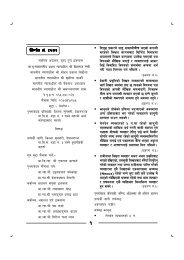The Nepali Judiciary - Supreme Court Of Nepal
The Nepali Judiciary - Supreme Court Of Nepal
The Nepali Judiciary - Supreme Court Of Nepal
You also want an ePaper? Increase the reach of your titles
YUMPU automatically turns print PDFs into web optimized ePapers that Google loves.
have been analyzed. Likewise, the concept of the stakeholders and comments received therein<br />
and strategic issues to be addressed by the second Plan has also been discussed in this chapter.<br />
Indicators and core functions of the judiciary have been included in the fifth chapter. Core functions<br />
address the following functions: adjudication, execution of judgment and supervision. Chapter six<br />
contains 12 strategic interventions. Strategic interventions have been based on the goals and<br />
objectives. Possible risks that may be faced during the implementation of the strategic<br />
interventions have been identified under chapter seven means of mitigating such risks have been<br />
stated therein. Activities to be initiated under strategic interventions, its results, indicators, timeline<br />
and responsibility and implementation plan have been mentioned under chapter eight. Chapter<br />
nine prescribes the budget required deemed necessary for operating the proposed activities in<br />
order to meet the goals and objectives determined by the Plan. Various data and name list of<br />
participants taking part in consultation meetings have been attached in the Annex.<br />
1.5 Vision, Mission and Values<br />
<strong>The</strong> first Strategic Plan of the <strong><strong>Nepal</strong>i</strong> <strong>Judiciary</strong> had for the first time defined the vision, mission and<br />
values of the judiciary. <strong>The</strong> vision, mission and values defined by the first Plan have been<br />
maintained with minor changes. Under the second Plan, commitment and ownership deemed<br />
necessary for the implementation of the Plan has been added as one of the values. <strong>The</strong> strategic<br />
plan has envisaged the vision as mission, target as path to the mission and values as guiding<br />
principles of the proceedings of the judiciary.<br />
<strong>The</strong> vision of the <strong><strong>Nepal</strong>i</strong> judiciary is to establish a system of justice which is independent,<br />
competent, inexpensive, speedy, effective and accessible to the public, worthy of public trust and<br />
thereby to transform the concept of the rule of law and human into a living reality and thus ensure<br />
justice for all whereas the mission is to impart fair and impartial justice in accordance with the<br />
provisions of the Constitution, the laws and the recognized principles of justice. Values are defined<br />
as allegiance to the Constitution, independence and autonomy, duty towards society, accessibility<br />
of justice, competent justice, high ethical standard, representation and inclusiveness and<br />
ownership.<br />
1.6 Review of the First Plan<br />
<strong>The</strong> first Plan had identified four core functions of the judiciary wherein with the conclusion of a<br />
mid-term review of the Plan the Advisory function had been removed thereby resulting in only three<br />
core functions. For the effective implementation of the core functions, 16 strategic interventions<br />
had been identified in the first Plan wherein with the conclusion of a mid-term review some of the<br />
strategic interventions identified by the core functions were suspended whereas some were<br />
adjusted or added resulting in 21 strategic interventions by end of the Plan. On the basis of the<br />
indicators a review of the core function and strategic interventions were made which was based on<br />
the fiscal year beginning from 2061/062 till 2064/065.<br />
During the project, mixed results have been noticed with regards to adjudication function of all the<br />
courts and other judicial tribunals. <strong>The</strong> objective for each fiscal year was to reduce 10% backlog of<br />
cases wherein the <strong>Supreme</strong> <strong>Court</strong> with regards to writ petition has been able to reduce 2.69%<br />
backlog of cases each year, whereas with regards to the initial and appellate jurisdiction, the<br />
backlog of cases have been reduced and in totality 9.09% of cases have been reduced each year.<br />
Although the target to reduce cases exceeding two years to zero could not be achieved, cases<br />
exceeding two years for the first year was 6,752 wherein by end of the fourth year the case stood<br />
at 4,330 thereby indicating some reduction in the number of cases. Pursuant to the overall data of<br />
the <strong>Supreme</strong> <strong>Court</strong>, the ration of registration of cases is decreasing and the speed of disposal of<br />
cases is on the rise.<br />
ii




![lg0f{o g+=&(&# g]=sf=k= @)^% ;af]{Rr cbfnt ljz]if Ohnf; ;DdfggLo k ...](https://img.yumpu.com/10045627/1/190x245/lg0fo-g-gsfk-afrr-cbfnt-ljzif-ohnf-ddfgglo-k-.jpg?quality=85)
![lg0f{o g+=&(@% g]=sf=k= @)^% ;jf]{Rr cbfnt, ljz]if Ohnf; dfggLo ...](https://img.yumpu.com/6479513/1/190x245/lg0fo-g-gsfk-jfrr-cbfnt-ljzif-ohnf-dfgglo-.jpg?quality=85)

![lgj]b s ljkIfL - Supreme Court Of Nepal](https://img.yumpu.com/5482729/1/190x245/lgjb-s-ljkifl-supreme-court-of-nepal.jpg?quality=85)